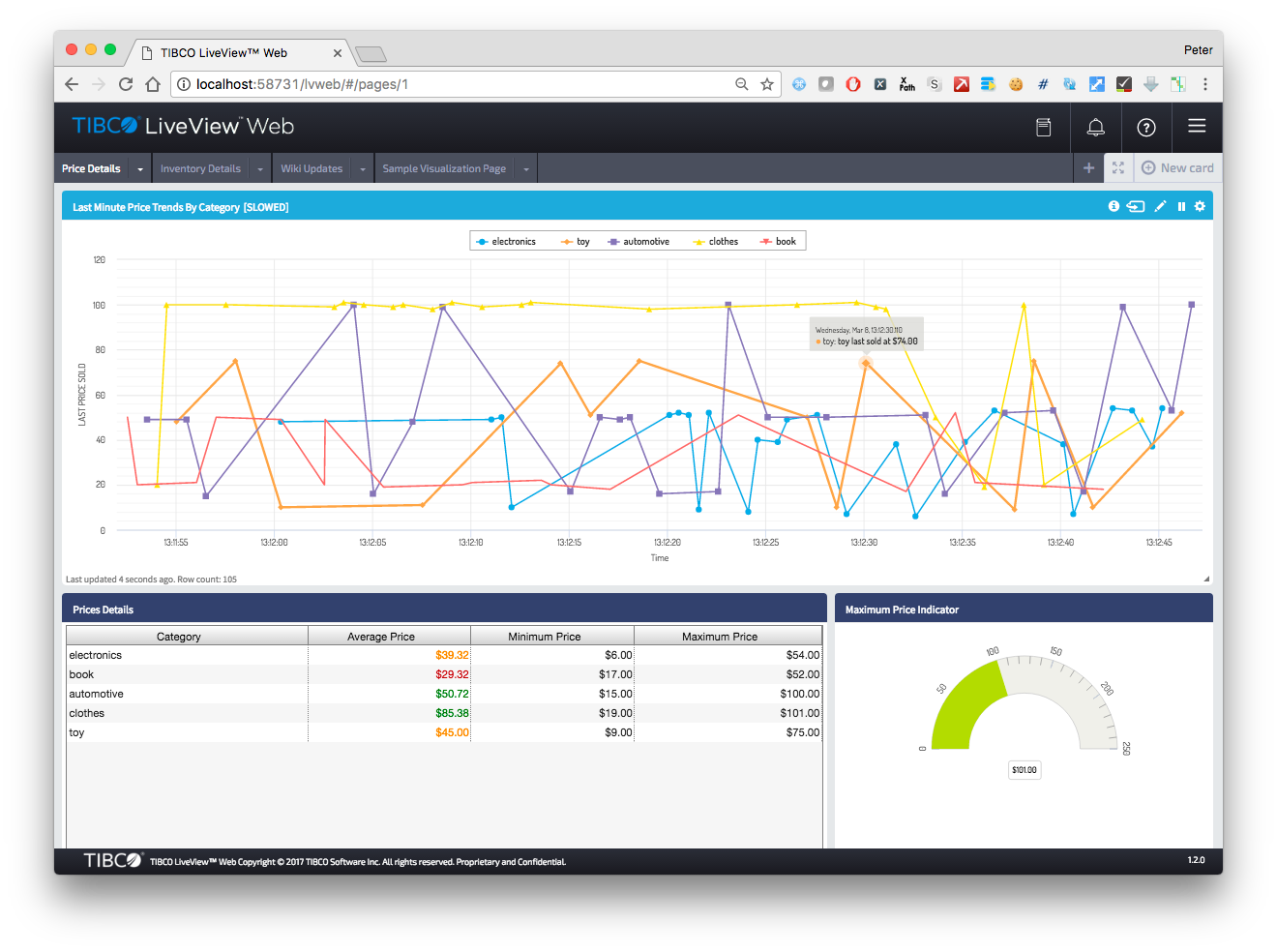LiveView fragment examples
The recommended LiveView directory structure is :
Note that the default source directory is set by the plugin to src/main/liveview.
The following pom.xml will build, unit test and install to the local maven repository, a LiveView fragment.
<?xml version="1.0" encoding="UTF-8"?>
<project xmlns="http://maven.apache.org/POM/4.0.0" xmlns:xsi="http://www.w3.org/2001/XMLSchema-instance" xsi:schemaLocation="http://maven.apache.org/POM/4.0.0 http://maven.apache.org/xsd/maven-4.0.0.xsd">
<!-- vim: set tabstop=4 softtabstop=0 expandtab shiftwidth=4 smarttab : -->
<modelVersion>4.0.0</modelVersion>
<groupId>com.tibco.ep</groupId>
<artifactId>lvfrag</artifactId>
<packaging>ep-liveview-fragment</packaging>
<version>1.0.0</version>
<name>hello world</name>
<!-- common definitions for this version of StreamBase -->
<parent>
<groupId>com.tibco.ep.sb.parent</groupId>
<artifactId>ep-liveview-fragment</artifactId>
<version>10.4.0}</version>
</parent>
</project>
When the maven install goal is called (mvn install), this pom.xml instructs maven to perform the following steps :
-
Uses install-product to check if the dependent product ( in this com.tibco.ep.thirdparty:tibco-sb_linuxx86_64 ) is installed. If its not, maven will download the archive and the plugin will extract into $TIBCO_EP_HOME.
-
Uses the standard maven plugin maven-compiler-plugin:testCompile to compile any java test sources to class files.
-
Uses start-nodes to start a test cluster.
Since this pom.xml has no configuration, a single node is started A.${artifactId} (ie A.goldylocks in this example) with a random but unused discovery port. -
Uses test-liveview-fragment to launch sbunit on the cluster and report the test results. Should the test cases fail then no further processing occurs.
-
Uses stop-nodes to stop and remove the test nodes
-
Uses package-liveview-fragment to create a LiveView fragment zip file in the build directory (by default, set to target) and attaches it to the build. Note that the fragment zip will include any LiveView Web plugins, themes and wars.
-
Uses the standard maven plugin maven-install-plugin:install to install the built and tested artifacts to the local maven repository.
Whilst launching of liveview is usually done when an application archive is deployed, its possible to start the fragment using deploy-fragment. For example a test case might want to start liveview and use playback to inject test data.
One challenge, though, is waiting for liveview to be completely started up - the maven-antrun-plugin can be used to monitor the log file.
...
<!-- common definitions for this version of StreamBase -->
<parent>
<groupId>com.tibco.ep.sb.parent</groupId>
<artifactId>ep-liveview-fragment</artifactId>
<version>10.4.0</version>
</parent>
...
<build>
<plugins>
<plugin>
<groupId>com.tibco.ep</groupId>
<artifactId>ep-maven-plugin</artifactId>
<extensions>true</extensions>
<executions>
<!-- start nodes -->
<execution>
<id>start nodes</id>
<phase>pre-integration-test</phase>
<goals><goal>start-nodes</goal></goals>
</execution>
<!-- deploy fragment -->
<execution>
<id>deploy fragment</id>
<phase>integration-test</phase>
<goals><goal>deploy-fragment</goal></goals>
<configuration>
<fragmentType>LIVEVIEW</fragmentType>
<target>liveview</target>
<arguments>
<argument>project=/Users/rkrajews/CSG/Code/SB/release-work/2.2.1/tibco-streaming-maven-plugin/ep-maven/src/main/liveview</argument>
</arguments>
</configuration>
</execution>
<!-- tests can be added -->
<!-- stop nodes -->
<execution>
<id>stop nodes</id>
<phase>post-integration-test</phase>
<goals><goal>stop-nodes</goal></goals>
</execution>
</executions>
</plugin>
<plugin>
<groupId>org.apache.maven.plugins</groupId>
<artifactId>maven-antrun-plugin</artifactId>
<executions>
<!-- wait for liveview to be started -->
<execution>
<id>wait for liveview</id>
<phase>integration-test</phase>
<goals><goal>run</goal></goals>
<configuration>
<target>
<!-- wait for max 5 minutes checking every 500ms -->
<waitfor maxwait="5" maxwaitunit="minute" checkevery="500">
<resourcecontains resource="/Users/rkrajews/CSG/Code/SB/release-work/2.2.1/tibco-streaming-maven-plugin/ep-maven/target/test-nodes/A.ep-maven-plugin/liveview0.out" substring="LiveView is ready to accept client connections"/>
</waitfor>
</target>
<skip>${skipTests}</skip>
</configuration>
</execution>
</executions>
</plugin>
</plugins>
</build>
The LiveView Web war file is a maven dependency and can be added to a project thus :
...
<!-- common definitions for this version of StreamBase -->
<parent>
<groupId>com.tibco.ep.sb.parent</groupId>
<artifactId>ep-liveview-fragment</artifactId>
<version>10.4.0</version>
<relativePath/>
</parent>
...
<dependencies>
...
<dependency>
<groupId>com.tibco.ep.lvweb</groupId>
<artifactId>lvweb</artifactId>
<type>war</type>
<scope>provided</scope>
</dependency>
...
</dependencies>
...
The parent pom will copy this dependency to the build directory ready to be added to the fragment archive :
...
[INFO] --- maven-dependency-plugin:2.8:copy-dependencies (copy lvweb) @ hellolvweb ---
[INFO] Copying lvweb-1.2.0.war to /Users/plord/workspace/dtmexamples/liveview-fragments/hellolvweb/target/classes/lv-user-webapps/lvweb.war
...
The LiveView application startup continues with :
...
[INFO] [A.hellolvweb] 2017-03-08 13:06:31.457+0000 [JettyService] INFO c.s.l.server.core.JettyService - LiveView Web service listening on non-SSL port 58731
...
[INFO] [A.hellolvweb] *** All tables have been loaded. LiveView is ready to accept client connections. Total start time(ms): 137945 ***
...
